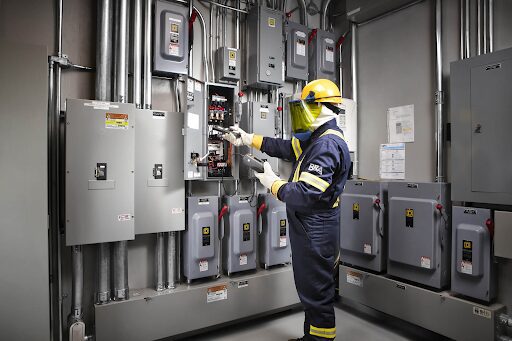Power is a significant component of our daily lives. However, with power comes great responsibility. Indeed, commercial electricians face many electrical hazards day-to-day. But how do commercial electricians combat these dangers and maintain a safe working environment?
Altogether, it is important to recognize workplace hazards in all industries. The electrical industry hosts many unwanted hazards that can pose serious risks to the safety and well-being of commercial electricians. Therefore, the only way to combat these hazards is to continuously learn about changing technology and its standards. Information is key and information can save the lives of commercial electricians.
Firstly, we will explore some electrical hazards that technicians face in their working environment. Secondly, dive into solutions to avoid those workplace hazards. Finally, discuss the processes used by Rogers Electric to mitigate electrical hazards for commercial electricians.
Electrical Shock Hazard
Electrical shock is the most common commercial electrical workplace hazard. Concurrently, there are various factors that can lead to electric shocks, including equipment malfunction, inadequate grounding, insufficient insulation, or human error.

Lock out/tag out featured on a job site.
Source: ClickSafety
How can an electrician avoid electrical shock on a job site?
- Use proper lockout/tagout procedures to ensure equipment is not energized for any type of maintenance.
- Wear appropriate PPE like insulated gloves, safety glasses, etc.
Arc Flash Electrical Hazard
Arc flash is one of the most dangerous workplace hazards for commercial electricians. It refers to the intense release of light and heat resulting from an arc fault explosion. The temperatures generated during an arc flash event can range between 5,000 to 35,000 °F.
What do commercial electricians do to ensure avoidance of arc flash?
- Begin by powering down electrical equipment, arc flashes can only occur with live voltage.
- Perform a comprehensive risk assessment to identify potential areas where arc flash incidents may arise.
- Use preventive measures like current-limiting fuses and arc-resistant switchgears to minimize the risk of arc flash.
- Ensure the use of appropriate PPE including face shields, arc-rated gloves, and protective clothing.
At Rogers Electric, our commercial electricians receive comprehensive safety training periodically and are kept up to date on the risks posed by arc flash incidents.

PPE equipment specific to arc flash.
Source: Lewis Bass
Trips and Falls Workplace Hazard
Workplace hazards present themselves in many forms. Some hazards are often overlooked in risk assessments. Surprisingly, another common hazard in the electrical working environment is related to trips and falls.
With elevated surfaces and many moving parts on job sites, this becomes a relevant hazard for commercial electricians. Furthermore, commercial electricians often navigate shared job sites where they must set the example for safety protocols. Avoidance of trips and falls can be accredited to:
- Fall protection systems are necessary for shared job sites. Fall protection can include safety harnesses, non-slip flooring, etc.
- Extensive training for lifts and ladders can mitigate potential risks for trips and falls.
Job sites can be a dangerous and hectic place for commercial electricians. In turn , having the awareness to recognize potential dangers can save lives. Awareness is important in the process of avoiding electrical hazards. Accordingly, embracing knowledge of new safety standards will contribute to avoidance of risks for commercial electricians. Although problems cant always be avoided, it is always good to be prepared.
Workplace Hazard Avoidance: Rogers Electric
At Rogers Electric, we strive to go above and beyond the necessary safety expectations and create an optimal work atmosphere on jobsites.
Rogers Electric provides in depth safety training for all of our commercial electricians. Accordingly, providing standardized and up-to-date safety protocols to all techs makes Rogers Electric a top provider when it comes to safety. In conjunction, our safety team implements ORM (Operational Risk Management) as well as the Safety 8 principles.
ORM involves evaluating potential risks, making informed decisions about them, and implementing appropriate measures to control or manage those risks. This process ultimately leads to mitigating or avoiding the identified risks. This system allows for a seamless process for commercial electricians when on a job site.
Assessing risks proactively leads to a healthy work environment where commercial electricians can work to their best ability. Leaving no room for error, our safety team re-enforces our standards and values to current and onboarded commercial electricians.
By requiring a safe work environment at all job sites nationally, Rogers continues to lead the way for quality work done right. Rogers Electric has continued to improve employee performance and client satisfaction by taking the steps to avoid electrical hazards. Learn more about our safety protocols to create safe work environments.


